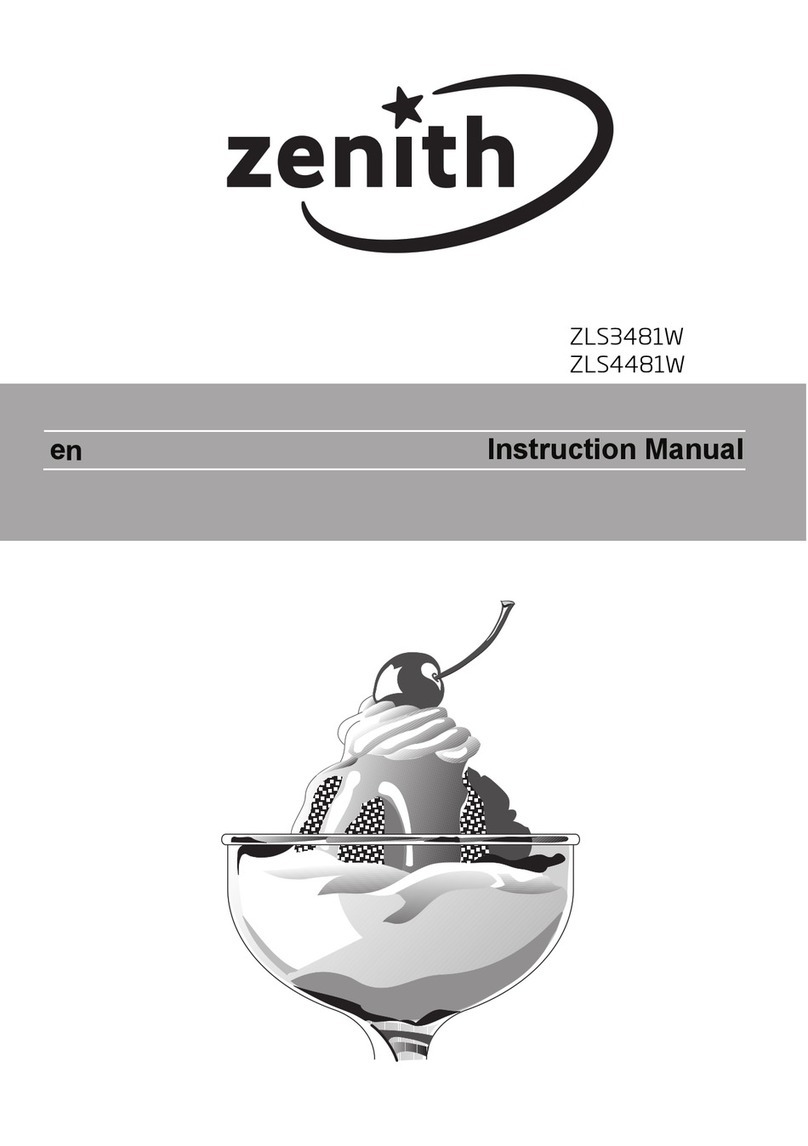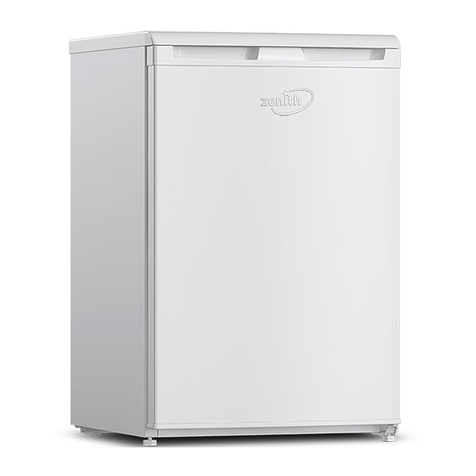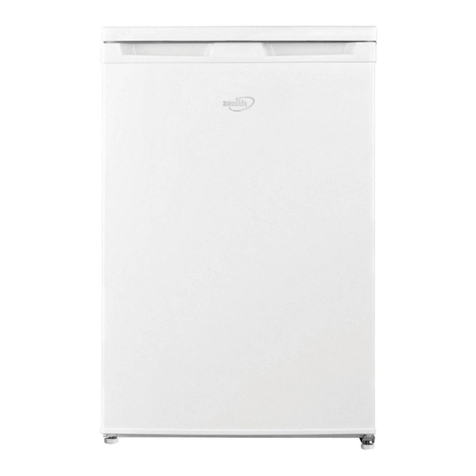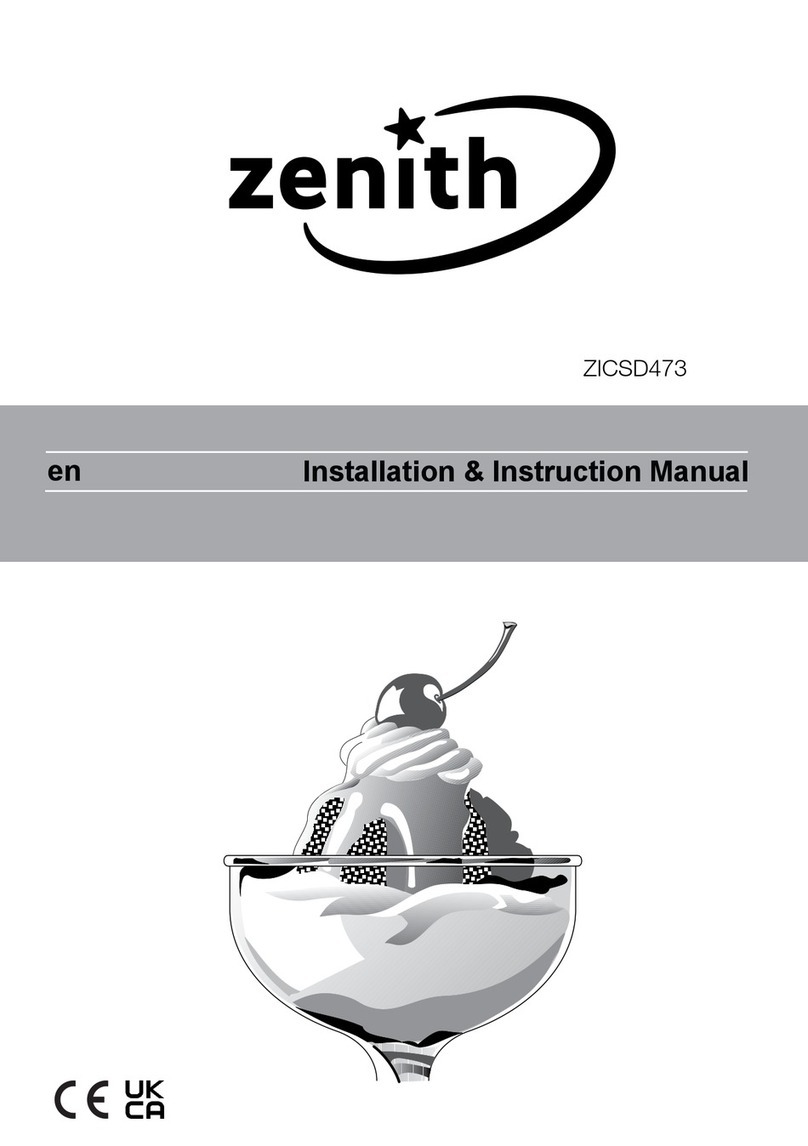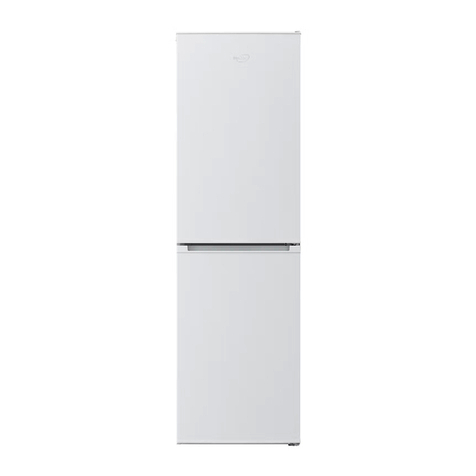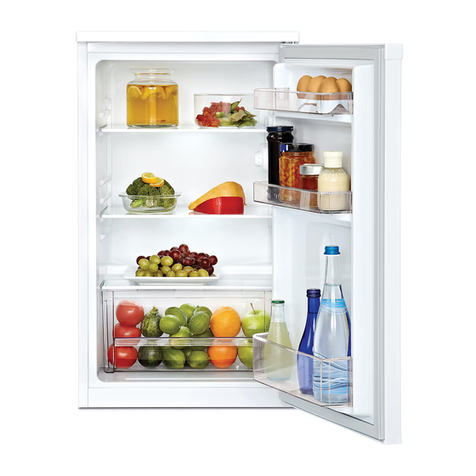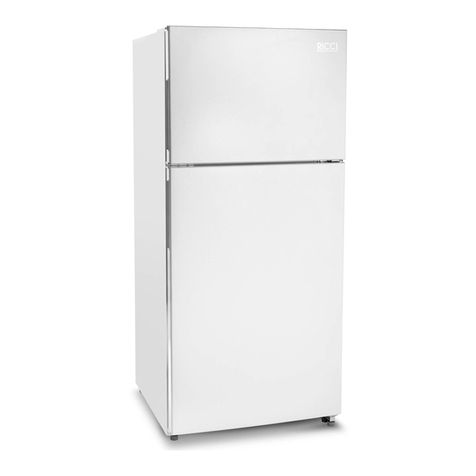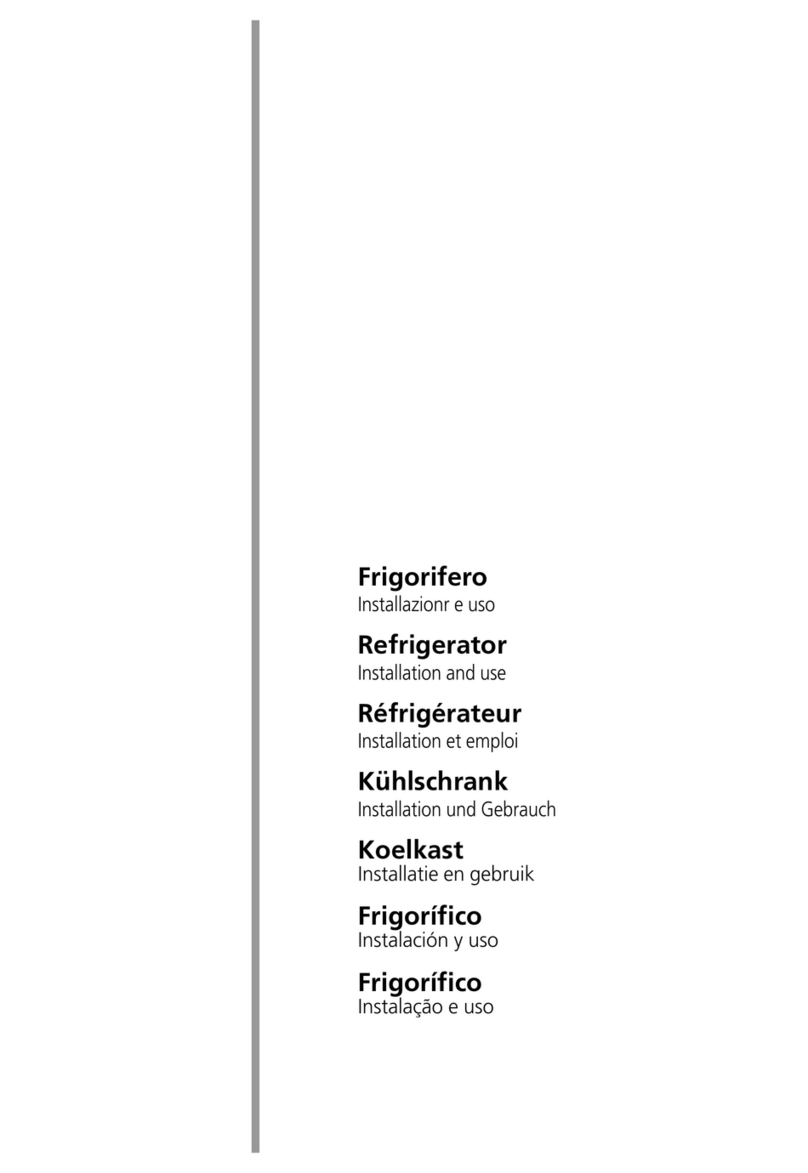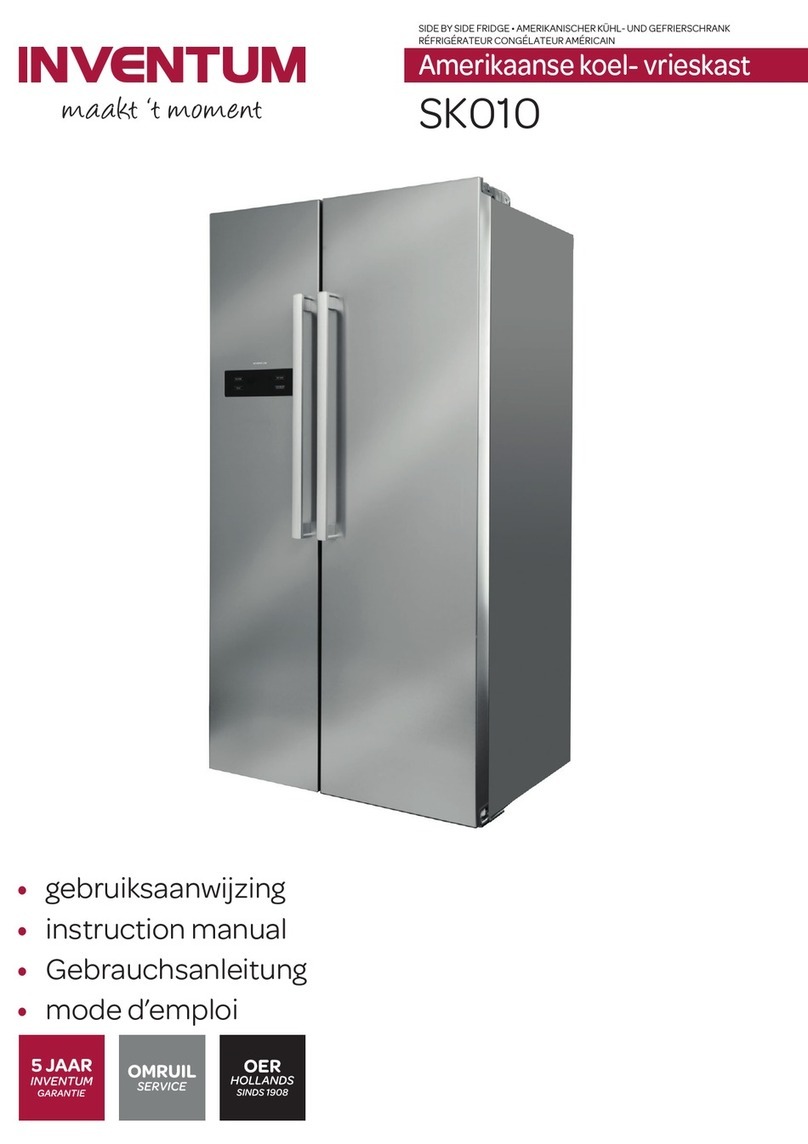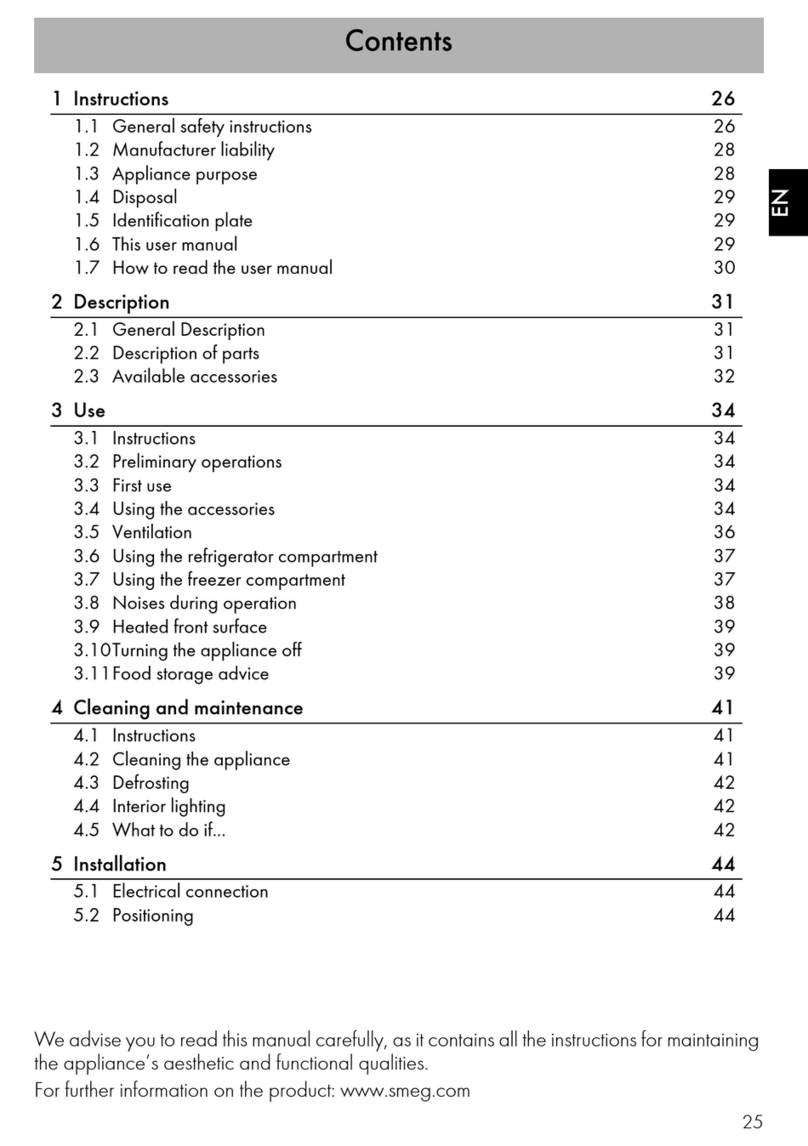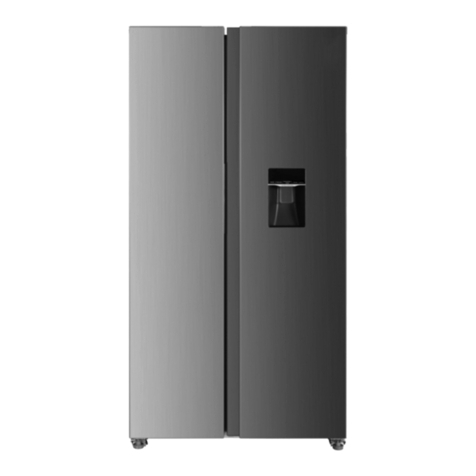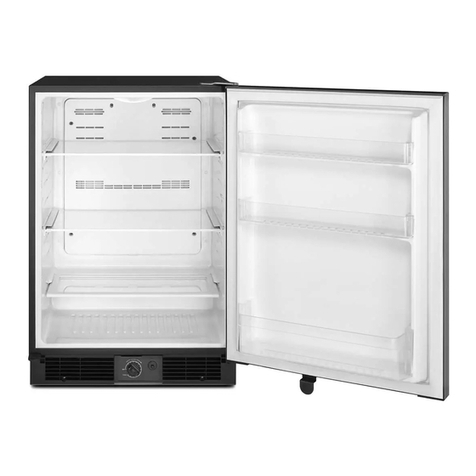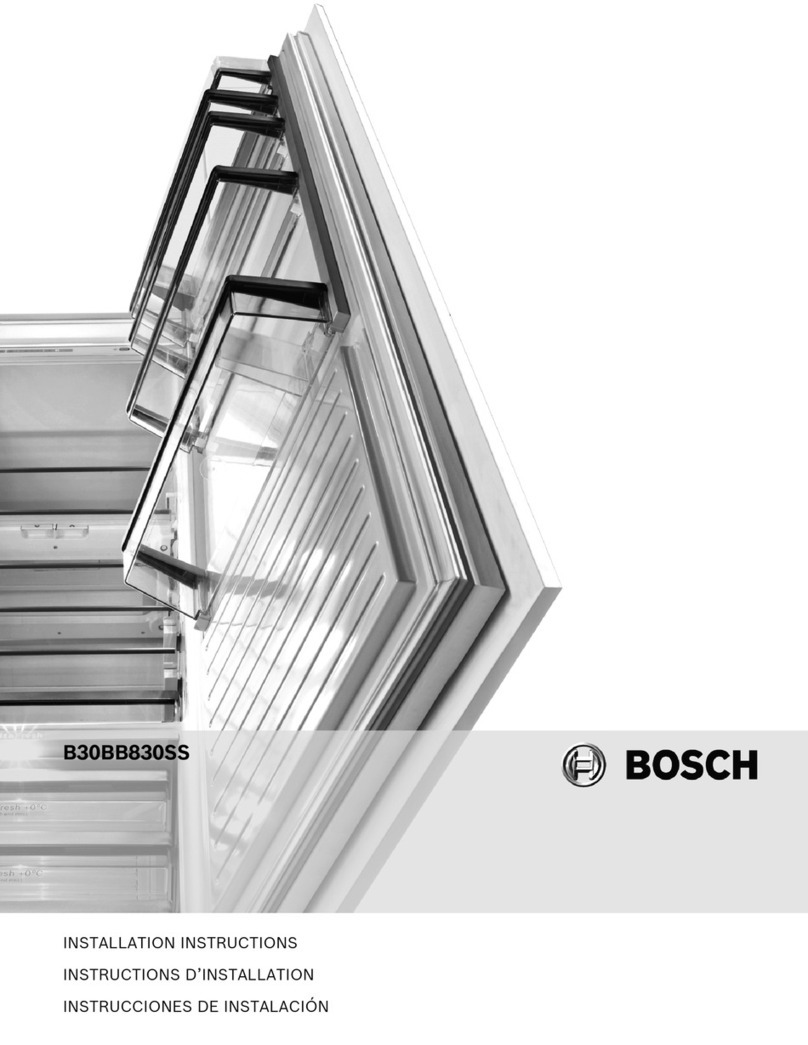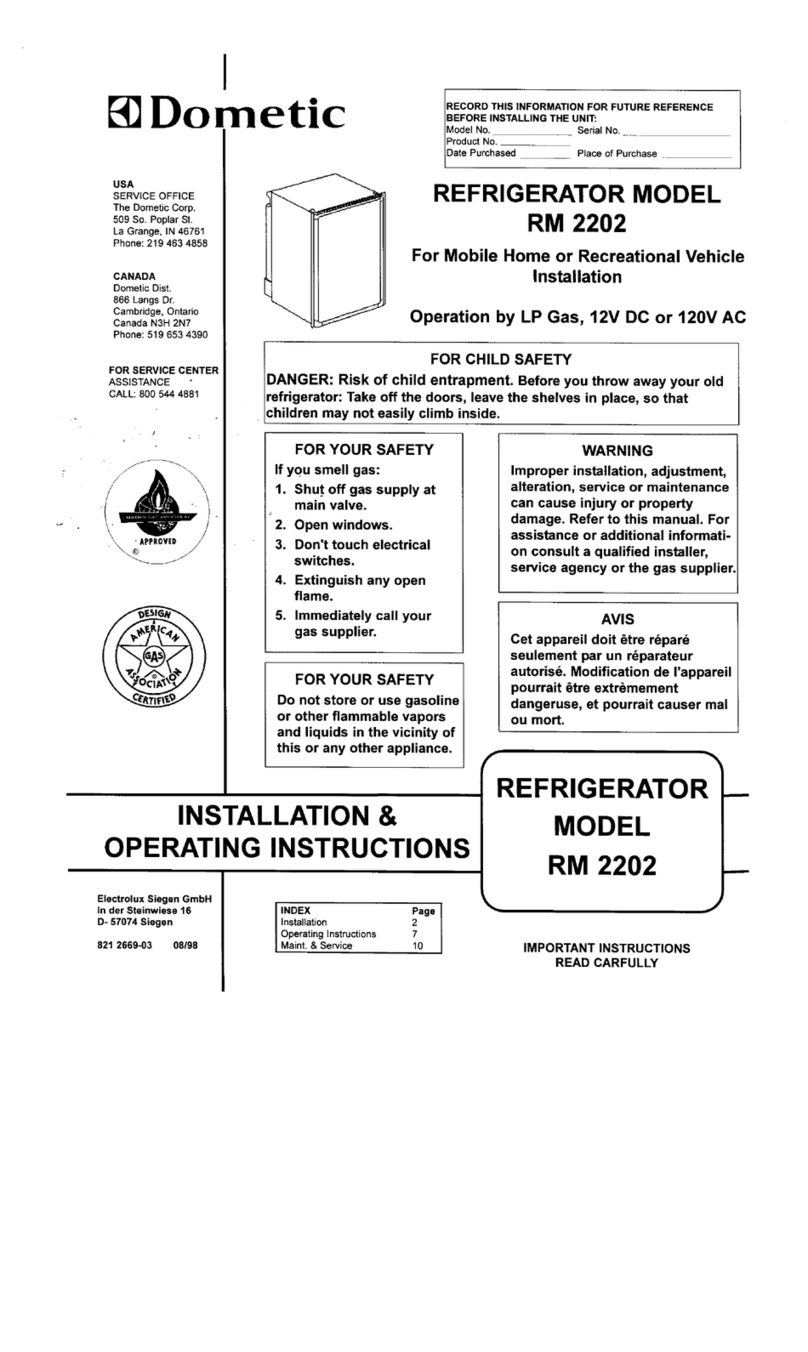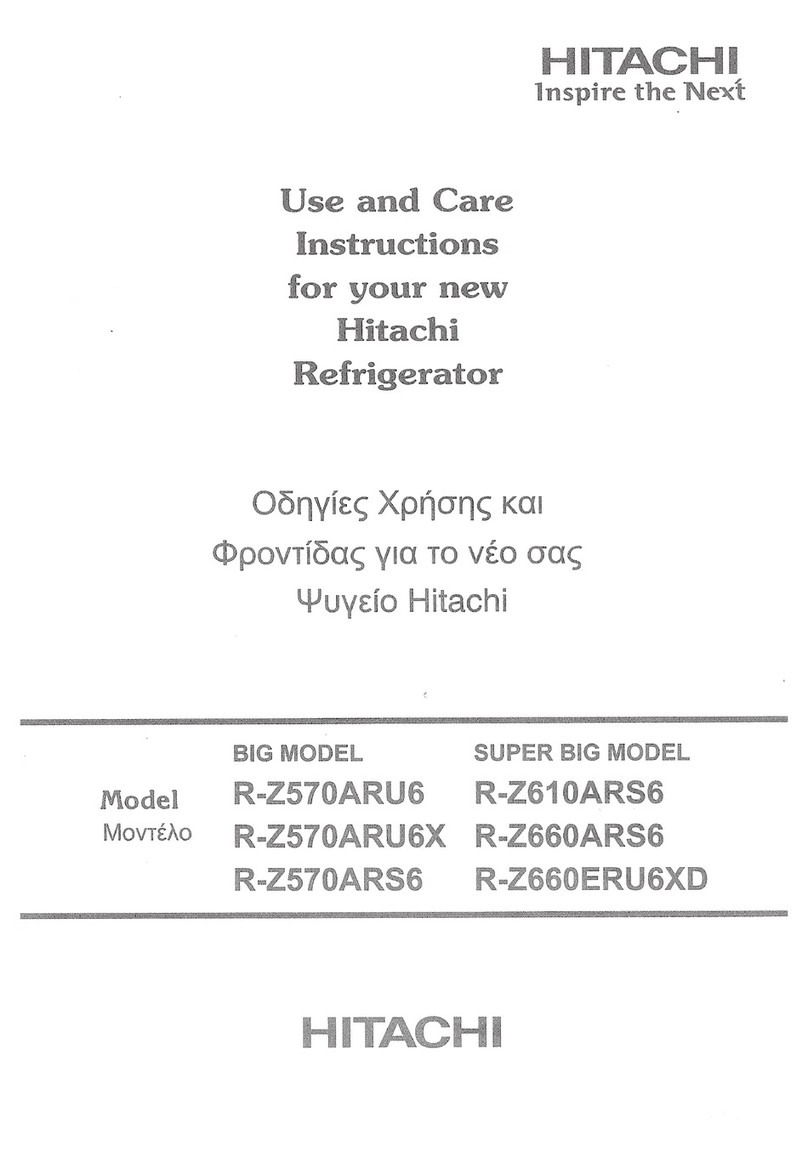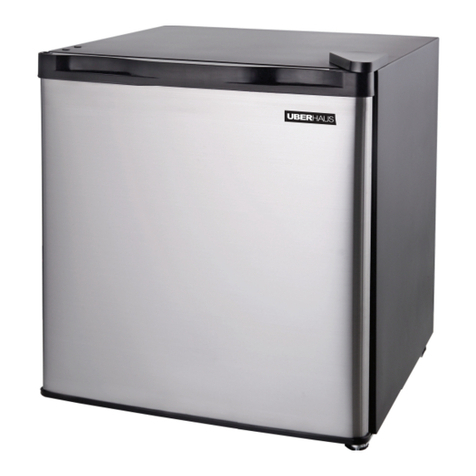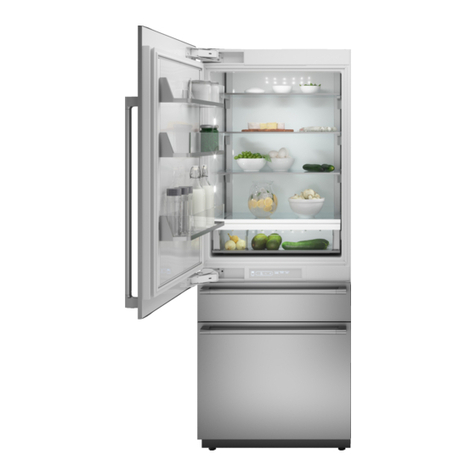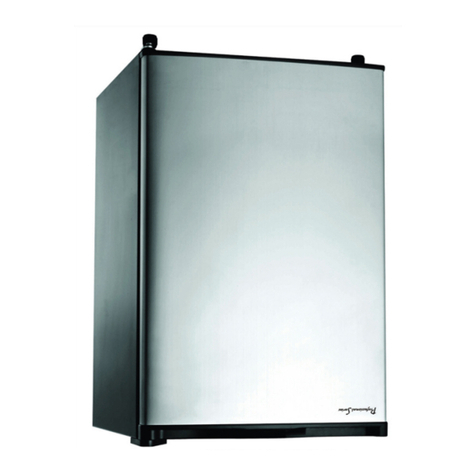Zenith ZCS4582W User manual

Instruction Manual
ZCS3582W
ZCS4582W

Please read this user manual first!
Dear Customer,
We hope that your product, which has been produced in modern plants and
checked under the most meticulous quality control procedures, will provide you
an effective service.
Therefore, read this entire user manual carefully before using the product and
keep it as a reference. If you handover the product to someone else, give the
user manual as well.
The user manual will help you use the product in a fast and safe way.
• Read the manual before installing and operating the product.
• Make sure you read the safety instructions.
• Keep the manual in an easily accessible place as you may need it later.
• Read the other documents given with the product.
Remember that this user manual is also applicable for several other models.
Differences between models will be identified in the manual.
Explanation of symbols
Throughout this user manual the following symbols are used:
CImportant information or useful tips.
AWarning against dangerous conditions for life and property.
BWarning against electric voltage.
A
A
A
C
SUPPLIER’S NAME MODEL IDENTIFIER (*)
INFORMATION
C
The model information as stored in the product data base
can be reached by entering following website and searching
for your model identifier (*) found on energy label.
https://eprel.ec.europa.eu/

EN
3
1 Your refrigerator 4
2 Safety and Environment
Instructions 5
General Safety............................................ 5
Intended Use...............................................8
Child Safety..................................................8
Compliance with WEEE Directive and
Disposing of the Waste Product .........8
Compliance with RoHS Directive.........8
Package Information................................8
3 Installation 9
Points to be paid attention to when
relocating the refrigerator.....................9
Electrical connection ...............................9
Disposing of the packaging.................10
Disposing of your old refrigerator....10
Placing and Installation.........................10
Adjusting the legs................................... 11
Chiller Compartment.............................. 11
Changing the illumination lamp ....... 11
4 Preparation 12
Reversing the doors...............................13
5 Using your freezer 14
Placing the food.......................................15
Defrosting .................................................16
6 Maintenance and
cleaning 17
Protection of plastic surfaces ...........17
7 Troubleshooting 18

EN
4
1Your refrigerator
CSome items mentioned in this instruction manual are generic and may not
correspond exactly wth your product. If the subject parts are not ncluded n
the product you have purchased, then t s vald for other models.
*May not be available in all models
4
5
2
3
6
6
7
8
9*
*10
*11
*1
*
1. Adjustable door shelves
2. Egg section
3. Bottle shelf
4. Adjustable Front Feet
5. Freezing and Storage (store
fresh food to be frozen lower down)
6. Freezer compartment
7. Chiller cover and glass
8. Adjustable shelves
9. Wine rack
10. Thermostat knob
11. Chiller compartment

EN
5
2Safety and Environment Instructions
This section provides the safety
instructions necessary to prevent the
risk of injury and material damage.
Failure to observe these instructions
will invalidate all types of product
warranty.
Intended use
A
WARNING:
Keep ventilation openings,
in the appliance enclosure or
in the built-instructure, clear
of obstruction.
A
WARNING:
Do not use mechanical
devices or other means to
accelerate the defrosting
process, other than those
recommended by the
manufacturer.
AWARNING:
Do not damage the
refrigerant circuit.
A
WARNING:
Do not use electrical
appliances inside the food
storage compartments
of the appliance, unless
they are of the type
recommended by the
manufacturer.
A
WARNING:
Do not store explosive
substances such as aerosol
cans with a flammable
propellant in this appliance.
This appliance is intended to be used
in household and similar applications
such as
– staff kitchen areas in shops, offices
and other working environments;
– farm houses and by clients in
hotels, motels and other residential
type environments;
– bed and breakfast type
environments;
– catering and similar non-retail
applications.
General Safety
• This product should not be
used by persons with physical,
sensory and mental disabilities,
without sufficient knowledge and
experience or by children. The device
can only be used by such persons
under supervision and instruction of
a person responsible for their safety.
Children should not be allowed to
play with this device.
• In case of malfunction, unplug the
device.
• After unplugging, wait at least 5
minutes before plugging in again.
• Unplug the product when not in use.
• Do not touch the plug with wet
hands! Do not pull the cable to plug
off, always hold the plug.
• Do not plug in the refrigerator if the
socket is loose.
• Unplug the product during
installation, maintenance, cleaning
and repair.
• If the product will not be used for
a while, unplug the product and
remove any food inside.
• Do not use the product when the
compartment with circuit cards
located on the upper back part of

EN
6
the product (electrical card box
cover) (1) is open.
1
1
• Do not use steam or steamed
cleaning materials for cleaning the
refrigerator and melting the ice
inside. Steam may come into contact
with the electrified areas and cause
short circuit or electric shock!
• Do not wash the product by spraying
or pouring water on it! Danger of
electric shock!
• In case of malfunction, do not use
the product, as it may cause electric
shock. Contact the authorized
service before doing anything.
• Plug the product into an earthed
socket. Earthing must be done by a
qualified electrician.
• If the product has LED type lighting,
contact the authorized service for
replacing or in case of any problem.
• Do not touch frozen food with wet
hands! It may adhere to your hands!
• Do not place liquids in bottles and
cans into the freezer compartment.
They may burst out!
• Place liquids in upright position after
tightly closing the lid.
• Do not spray flammable substances
near the product, as it may burn or
explode.
• Do not keep flammable materials
and products with flammable gas
(sprays, etc.) in the refrigerator.
• Do not place containers holding
liquids on top of the product.
Splashing water on an electrified
part may cause electric shock and
risk of fire.
• Exposing the product to rain,
snow, sunlight and wind will cause
electrical danger. When relocating
the product, do not pull by holding
the door handle. The handle may
come off.
• Take care to avoid trapping any part
of your hands or body in any of the
moving parts inside the product.
• Do not step or lean on the door,
drawers and similar parts of the
refrigerator. This will cause the
product to fall down and cause
damage to the parts.
• Take care not to trap the power
cable.
• When positioning the appliance,
ensure the supply cord is not
trapped or damaged.
• Do not locate multiple portable
socket-outlets or portable power
supplies at the rear of the appliance.

EN
7
• Children aged from 3 to 8 years
are allowed to load and unload
refrigerating appliances.
• To avoid contamination of food,
please respect the following
instructions:
• – Opening the door for long
periods can cause a significant
increase of the temperature in the
compartments of the appliance.
• – Clean regularly surfaces that
can come in contact with food and
accessible drainage systems.
• – Clean water tanks if they have not
been used for 48 h; flush the water
system connected to a water supply
if water has not been drawn for 5
days.
• – Store raw meat and fish in suitable
containers in the refrigerator, so that
it is not in contact with or drip onto
other food.
• – Two-star frozen-food
compartments are suitable for
storing pre-frozen food, storing or
making icecream and making ice
cubes.
• – One-, two- and three-star
compartments are not suitable for
the freezing of fresh food.
• – If the refrigerating appliance is
left empty for long periods, switch
off, defrost, clean, dry, and leave
the door open to prevent mould
developing within the appliance.
1.1.1 HC Warning
If the product comprises a cooling
system using R600a gas, take care to
avoid damaging the cooling system
and its pipe while using and moving
the product. This gas is flammable. If
the cooling system is damaged, keep
the product away from sources of fire
and ventilate the room immediately.
C
The label on the inner left
side indicates the type of
gas used in the product.
1.1.2 For Models with
Water Dispenser
• Pressure for cold water inlet shall
be maximum 90 psi (6.2 bar). If
your water pressure exceeds 80
psi (5.5 bar), use a pressure limiting
valve in your mains system. If you
do not know how to check your
water pressure, ask for the help of a
professional plumber.
• If there is risk of water hammer
effect in your installation, always
use a water hammer prevention
equipment in your installation.
Consult Professional plumbers if you
are not sure that there is no water
hammer effect in your installation.
• Do not install on the hot water inlet.
Take precautions against of the
risk of freezing of the hoses. Water
temperature operating interval shall
be 33°F (0.6°C) minimum and 100°F
(38°C) maximum.
• Use drinking water only.

EN
8
Intended Use
• This product is designed for home
use. It is not intended for commercial
use.
• The product should be used to store
food and beverages only.
• Do not keep sensitive products
requiring controlled temperatures
(vaccines, heat sensitive medication,
medical supplies, etc.) in the
refrigerator.
• The manufacturer assumes no
responsibility for any damage due to
misuse or mishandling.
• Original spare parts will be provided
for 10 years, following the product
purchasing date.
Child Safety
• Keep packaging materials out of
children’s reach.
• Do not allow the children to play
with the product.
• If the product’s door comprises a
lock, keep the key out of children’s
reach.
Compliance with WEEE
Directive and Disposing of
the Waste Product
This product complies with
EU WEEE Directive (2012/19/EU). This
product bears a classification symbol
for waste electrical and electronic
equipment (WEEE).
This product has been
manufactured with high
quality parts and materials
which can be reused and
are suitable for recycling.
Do not dispose of the
waste product with
normal domestic and other wastes at
the end of its service life. Take it to the
collection center for the recycling of
electrical and electronic equipment.
Please consult your local authorities
to learn about these collection
centers.
Compliance with RoHS
Directive
• This product complies with EU WEEE
Directive (2011/65/EU). It does
not contain harmful and prohibited
materials specified in the Directive.
Package Information
Packaging materials of the product
are manufactured from recyclable
materials in accordance with our
National Environment Regulations. Do
not dispose of the packaging materials
together with the domestic or other
wastes. Take them to the packaging
material collection points designated
by the local authorities.

EN
9
3Installation
BThe manufacturer will not be liable
for any event caused by disregarding
the information supplied in this user
manual.
Points to be paid attention
to when relocating the
refrigerator
1. Your refrigerator should be
unplugged.Before transportation of
your refrigerator, it should be emptied
and cleaned.
2. Before it is re-packaged,
shelves, accessories, crisper, etc.
inside your refrigerator should be
fixed with adhesive tape and secured
against impacts. Package should be
bound with a thick tape or sound
ropes and the transportation rules
on the package should be strictly
observed.
3. Original packaging and foam
materials should be kept for future
transportations or moving.
Before you start the refrigerator,
Check the following before you
start to use your refrigerator:
1. Attach 2 plastic wedges as
illustrated below. Plastic wedges
are intended to keep the distance
which will ensure the air circulation
between your refrigerator and the
wall. (The picture is drawn up as a
representation and it is not identical
with your product.)
2. Clean the interior of the
refrigerator as recommended in the
“Maintenance and cleaning” section.
3. Connect the plug of the
refrigerator to the wall socket. When
the fridge door is opened, fridge
internal lamp will turn on.
4. When the compressor starts to
operate, a sound will be heard. The
liquid and gases sealed within the
refrigeration system may also give
rise to noise, even if the compressor
is not running and this is quite normal.
5. Front edges of the refrigerator
may feel warm. This is normal. These
areas are designed to be warm to
avoid condensation.
Electrical connection
Connect your product to a grounded
socket which is being protected by a
fuse with the appropriate capacity.
Important:
The connection must be in
compliance with national regulations.
• The power plug must be easily
accessible after installation.
• Electrical safety of your refrigerator
shall be guaranteed only if the earth
system in your house complies with
standards.
• The voltage stated on the label
located at left inner side of your
product should be equal to your
network voltage.

EN
10
• Extension cables and multi plugs
must not be used for connection.
BA damaged power cable must be
replaced by a qualified electrician.
BProduct must not be operated
before it is repaired! There is the risk
of electric shock!
Disposing of the packaging
The packing materials may be
dangerous for children. Keep the
packing materials out of the reach
of children or dispose of them by
classifying them in accordance with
the waste instructions stated by your
local authorities. Do not throw away
with regular house waste, throw away
on packaging pick up spots designated
by the local authorities.
The packing of your refrigerator is
produced from recyclable materials.
Disposing of your old
refrigerator
Dispose of your old refrigerator
without giving any harm to the
environment.
• You may consult your authorized
dealer or waste collection center of
your municipality about the disposal
of your refrigerator.
Before disposing of your refrigerator,
cut off the electric plug and, if there
are any locks on the door, make them
inoperable in order to protect children
against any danger.
Placing and Installation
AIf the entrance door of the room
where the refrigerator will be installed
is not wide enough for the refrigerator
to pass through, then carefully remove
the doors of your refrigerator and pass
it sideways through the door.
1. Install your refrigerator to a
place that allows ease of use.
2. Keep your refrigerator away
from heat sources, humid places and
direct sunlight.
3. There must be appropriate air
ventilation around your refrigerator
in order to achieve an efficient
operation. If the refrigerator is to be
placed in a recess in the wall, there
must be at least 5 cm distance with
the ceiling and at least 5 cm with the
wall. Do not place your product on the
materials such as rug or carpet.
4. Place your refrigerator on an
even floor surface to prevent jolts.
5. This product cannot be used in
rooms where the temperature drops
below 5°C.
WARNING:
Do not locate extension
sockets or charging
transformers/power supplies or
Lithium-Iron battery operated
products adjacent to the compressor
as they could overheat.

EN
11
Adjusting the legs
If your refrigerator is unbalanced;
You can balance your refrigerator
by turning its front legs as illustrated
in the figure. The corner where the
leg exists is lowered when you turn
in the direction of black arrow and
raised when you turn in the opposite
direction. Taking help from someone
to slightly lift the refrigerator will
facilitate this process.
Chiller Compartment
With the help of 0 °C compartment
you can keep your wrapped meat
and fish food 2-3 times longer than a
standard fridge compartment.
Do not store fruits and vegetables in
this compartment.
The condenser of your appliance is located on the back as shown below.
In order to achieve better energy efficiency with lower energy consumption,
please pull the condenser towards yourself as illustrated in picture below.
*may not be available in all models
better energy
efficiency
2-b
initial position
PULL
PULL
Changing the illumination
lamp
To change the Bulb/LED used for
illumination of your refrigerator, call
your AuthorisedService.
The lamp(s) used in this appliance
is not suitable for household room
illumination. The intended purpose
of this lamp is to assist the user to
place foodstuffs in the refrigerator/
freezer in a safe and comfortable
way.The lamps used in this appliance
have to withstand extreme physical
conditions such as temperatures
below -20 °C.
(only chest and upright freezer)
This product is equipped with a
lighting source of the “G” energy class.
The lighting source in this product
shall only be replaced by professional
repairers.

EN
12
4Preparation
• Your refrigerator should be installed
at least 30 cm away from heat
sources such as hobs, ovens, central
heater and stoves and at least 5
cm away from electrical ovens and
should not be located under direct
sunlight.
• Please make sure that the interior
of your refrigerator is cleaned
thoroughly.
• If two refrigerators are to be
installed side by side, there should
be at least 2 cm distance between
them.
• When you operate your refrigerator
for the first time, please observe the
following instructions during the
initial six hours.
• The door should not be opened
frequently.
• It must be operated empty without
any food in it until it reaches set
temperature.
• If there is a power failure do not
open the door. Frozen food should
not be affected if the failure lasts
for less than 15 hours. If the failure
is longer, then the food should
be checked and either eaten
immediately or cooked and then re-
frozen.
• Original packaging and foam
materials should be kept for future
transportations or moving.
• For temporary storage of larger
items in the freezer the shelves/
baskets can be removed as required.
• Food contact with the temperature
sensor in the freezer compartment
may increase energy consumption
of the appliance. Thus any contact
with the sensor(s) must be avoided.
• In some models, the instrument
panel automatically turns off 5
minutes after the door has closed.
It will be reactivated when the door
has opened or any key pressed.
• Due to temperature change as
a result of opening/closing the
product door during operation,
condensation on the door/body
shelves and the glass containers is
normal especially in Summer.

EN
13
Reversing the doors
Proceed in numerical order
1
3
2
67
8
5
4
9
10
11
12
13
14
15
16
17
18
19
20
21
22
23
24
25
26
27
28

EN
14
5Using your freezer
The operating temperature is
regulated by the temperature control.
Warm Cold
1 2 3 4 5
(Or) Min. Max.
0=System cooling is off.
1=Lowest cooling setting
(Warmest setting).
5=Highest cooling setting (Coldest
setting).
The average temperature inside the
fridge should be around +5°C.
Please choose the setting according
to the desired temperature.
Please note that there will be
different temperatures in the cooling
area.
The coldest region is immediately
above the vegetable compartment.
The interior temperature also
depends on ambient temperature,
the frequency with which the door is
opened and the amount of foods kept
inside.
Frequently opening the door causes
the interior temperature to rise.
For this reason, it is recommended
to close the door again as soon as
possible after use.
The interior temperature of your
refrigerator changes for the following
reasons;
• Seasonal temperatures,
• Frequent opening of the door and
leaving the door open for long
periods,
• Food put into the refrigerator
without cooling down to the room
temperature,
• The location of the refrigerator in
the room (e.g. exposing to sunlight).
• You may adjust the varying interior
temperature due to such reasons
by using the thermostat.
Coolng
Food storage
The frdge compartment s for the
short-term storage of fresh food and
drnks.
Store mlk products n the ntended
compartment n the cooler/freezer.
Bottles can be stored n the bottle
holder or n the bottle shelf of the
door.
Raw meat s best kept n a
polyethylene bag n the compartment
at the very bottom of the cooler/
freezer.
Allow hot foods and beverages to
cool to room temperature pror to
placng them n the cooler/freezer.

EN
15
• Attenton
Store concentrated alcohol only
standng uprght and tghtly closed.
• Attenton
Do not store explosve substances or
contaners wth flammable propellant
gases (canned cream, spray cans etc.)
n the freezer. There s a danger of
exploson.
Placing the food
Egg tray Egg
Fridge
compartment
shelves
Food in pans, covered
plates and closed
containers
Fridge
compartment door
shelves
Small and packaged
food or drinks (such
as milk, fruit juice and
beer)
Crisper Vegetables and fruits

EN
16
Defrosting
A) Fridge Compartment
The fridge compartment defrosts
automatically. The defrosting water
runs to the drain tube via a collection
container at the back of the appliance
(1). (see diagram) During defrosting
water droplets may form at the back
of the fridge compartment where
concealed evaporator is located.
Some droplets may remain on the
liner and refreeze when defrosting is
completed. Do not allow items in the
fridge to touch the back wall as the
water droplets will make them wet.
Do not use pointed or sharp edged
objects such as knives, forks to remove
the droplets which have frozen.
If at any time the defrost water does
not drain from the collection channel,
check to ensure that no food particles
have blocked the drain tube. The drain
tube can be cleared by pushing the
special plastic plunger provided down
the drain tube (2). If the frost layer
reaches about 1/4”(7 mm), reduce
the setting (i.e. from 4 to 1) to restart
automatic defrosting.
B) Freezer compartment
Defrosting is very straightforward
and without mess, thanks to a special
defrost collection basin.
Defrost twice a year or when a
frost layer of around 7 (1/4”) mm
has formed. To start the defrosting
procedure, switch off the appliance
at the socket outlet and pull out the
mains plug.
All food should be wrapped in several
layers of newspaper and stored in a
cool place (e.g. fridge or larder).
Containers of warm water may be
placed carefully in the freezer to
speed up the defrosting.
Do not use pointed or sharp-edged
objects, such as knives or forks to
remove the frost.
Never use hairdryers, electrical
heaters or other such electrical
appliances for defrosting.
Sponge out the defrost water
collected in the bottom of the freezer
compartment. After defrosting, dry
the interior thoroughly.
Insert the plug into the wall socket
and switch on the electricity supply.

EN
17
6Maintenance and cleaning
ANever use gasoline, benzene or
similar substances for cleaning
purposes.
BWe recommend that you unplug the
appliance before cleaning.
BNever use any sharp abrasive
instrument, soap, household
cleaner, detergent and wax polish
for cleaning.
B For non-No Frost products,
water drops and frosting up to a
fingerbreadth occur on the rear wall
of the Fridge compartment. Do not
clean it; never apply oil or similar
agents on it.
BOnly use slightly damp microfiber
cloths to clean the outer surface
of the product. Sponges and other
types of cleaning cloths may scratch
the surface.
CUse lukewarm water to clean the
cabinet of your refrigerator and wipe
it dry.
CUse a damp cloth wrung out in
a solution of one teaspoon of
bicarbonate of soda to one pint of
water to clean the interior and wipe
it dry.
BMake sure that no water enters the
lamp housing and other electrical
items.
BIf your refrigerator is not going to
be used for a long period of time,
unplug the power cable, remove all
food, clean it and leave the door ajar.
CCheck door seals regularly to ensure
they are clean and free from food
particles.
ATo remove door racks, remove all the
contents and then simply push the
door rack upwards from the base.
ANever use cleaning agents or water
that contain chlorine to clean the
outer surfaces and chromium coated
parts of the product. Chlorine causes
corrosion on such metal surfaces.
ADo not use sharp, abrasive tools,
soap, household cleaning agents,
detergents, kerosene, fuel oil,
varnish etc. to prevent removal and
deformation of the prints on the
plastic part. Use lukewarm water
and a soft cloth for cleaning and
then wipe it dry.
Protection of plastic
surfaces
CDo not put the liquid oils or oil-
cooked meals in your refrigerator
in unsealed containers as they
damage the plastic surfaces of your
refrigerator. In case of spilling or
smearing oil on the plastic surfaces,
clean and rinse the relevant part
of the surface at once with warm
water.

EN
18
7Troubleshooting
Please review this list before calling
the service. It will save your time and
money. This list includes frequent
complaints that are not arising from
defective workmanship or material
usage. Some of the features described
here may not exist in your product.
The refrigerator does not operate.
• The plug is not inserted into the
socket correctly. >>>Insert the plug
into the socket securely.
• The fuse of the socket which your
refrigerator is connected to or the
main fuse have blown out. >>>Check
the fuse.
Condensation on the side wall of the
fridge compartment (MULTIZONE, COOL
CONTROL and FLEXI ZONE).
• Door has been opened frequently.
>>>Do not open and close the door
of refrigerator frequently.
• Ambient is very humid. >>>Do not
install your refrigerator into highly
humid places.
• Food containing liquid is stored in
open containers. >>>Do not store
food with liquid content in open
containers.
• Door of the refrigerator is left ajar.
>>>Close the door of the refrigerator.
• Thermostat is set to a very cold level.
>>>Set the thermostat to a suitable
level.
• Compressor is not running
• Protective thermic of the compressor
will blow out during sudden power
failures or plug-out plug-ins as the
refrigerant pressure in the cooling
system of the refrigerator has not
been balanced yet. The refrigerator
will start running approximately after
6 minutes. Please call the service if
the refrigerator does not startup at
the end of this period.
• The fridge is in defrost cycle. >>>This
is normal for a full-automatically
defrosting refrigerator. Defrosting
cycle occurs periodically.
• The refrigerator is not plugged into
the socket. >>>Make sure that the
plug is fit into the socket.
• Temperature settings are not made
correctly. >>>Select the suitable
temperature value.
• There is a power outage.
>>>Refrigerator returns to normal
operation when the power restores.
The operation noise increases when
the refrigerator is running.
• The operating performance of the
refrigerator may change due to the
changes in the ambient temperature.
It is normal and not a fault.

EN
19
The refrigerator is running frequently
or for a long time.
• New product may be wider than the
previous one. Larger refrigerators
operate for a longer period of time.
• The room temperature may be high.
>>>It is normal that the product
operates for longer periods in hot
ambient.
• The refrigerator might be plugged in
recently or might be loaded with food.
>>>When the refrigerator is plugged
in or loaded with food recently, it will
take longer for it to attain the set
temperature. This is normal.
• Large amounts of hot food might
be put in the refrigerator recently.
>>>Do not put hot food into the
refrigerator.
• Doors might be opened frequently
or left ajar for a long time. >>>The
warm air that has entered into the
refrigerator causes the refrigerator
to run for longer periods. Do not open
the doors frequently.
• Freezer or fridge compartment door
might be left ajar. >>>Check if the
doors are closed completely.
• The refrigerator is adjusted to a very
low temperature. >>>Adjust the
refrigerator temperature to a warmer
degree and wait until the temperature
is achieved.
• Door seal of the fridge or freezer
may be soiled, worn out, broken or
not properly seated. >>>Clean or
replace the seal. Damaged/broken
seal causes the refrigerator to run
for a longer period of time in order to
maintain the current temperature.
Freezer temperature is very low while
the fridge temperature is sufficient.
• The freezer temperature is adjusted
to a very low value. >>>Adjust the
freezer temperature to a warmer
degree and check.
Fridge temperature is very low while
the freezer temperature is sufficient.
• The fridge temperature is adjusted
to a very low value. >>>Adjust the
fridge temperature to a warmer
degree and check.
Food kept in the fridge compartment
drawers is frozen.
• The fridge temperature is adjusted
to a very high value. >>>Adjust the
fridge temperature to a lower value
and check.
Temperature in the fridge or freezer is
very high.
• The fridge temperature is adjusted
to a very high value. >>>Fridge
compartment temperature setting
has an effect on the temperature of
the freezer. Change the temperatures
of the fridge or freezer and wait until
the relevant compartments attain a
sufficient temperature.
• Doors are opened frequently or left
ajar for a long time. >>>Do not open
the doors frequently.
• Door is ajar. >>>Close the door
completely.
• The refrigerator is plugged in or
loaded with food recently. >>>This
is normal. When the refrigerator
is plugged in or loaded with food
recently, it will take longer for it to
attain the set temperature.
• Large amounts of hot food might
be put in the refrigerator recently.
>>>Do not put hot food into the
refrigerator.

EN
20
• Vibrations or noise.
• The floor is not level or stable. >>>
If the refrigerator rocks when moved
slowly, balance it by adjusting its feet.
Also make sure that the floor is strong
enough to carry the refrigerator, and
level.
• The items put onto the refrigerator
may cause noise. >>>Remove the
items on top of the refrigerator.
There are noises coming from the
refrigerator like liquid flowing, spraying,
etc.
• Liquid and gas flows occur in
accordance with the operating
principles of your refrigerator. It is
normal and not a fault.
Whistle comes from the refrigerator.
• Fans are used in order to cool the
refrigerator. It is normal and not a
fault.
Condensation on the inner walls of
refrigerator.
• Hot and humid weather increases
icing and condensation. It is normal
and not a fault.
• Doors are opened frequently or left
ajar for a long time. >>>Do not open
the doors frequently. Close them if
they are open.
• Door is ajar. >>>Close the door
completely.
Humidity occurs on the outside of the
refrigerator or between the doors.
• There might be humidity in the
air; this is quite normal in humid
weather. When the humidity is less,
condensation will disappear.
Bad odour inside the refrigerator.
• No regular cleaning is performed.
>>>Clean the inside of the
refrigerator regularly with a sponge,
lukewarm water or carbonate
dissolved in water.
• Some containers or package materials
may cause the smell. >>>Use a
different container or different brand
packaging material.
• Food is put into the refrigerator in
uncovered containers. >>>Keep
the food in closed containers.
Microorganisms spreading out from
uncovered containers can cause
unpleasant odours.
• Remove the foods that have expired
best before dates and spoiled from
the refrigerator.
The door is not closing.
• Food packages are preventing the
door from closing. >>>Replace the
packages that are obstructing the
door.
• The refrigerator is not completely
even on the floor. >>>Adjust the feet
to balance the refrigerator.
• The floor is not level or strong.
>>>Make sure that the floor is level
and capable to carry the refrigerator.
This manual suits for next models
1
Table of contents
Other Zenith Refrigerator manuals
